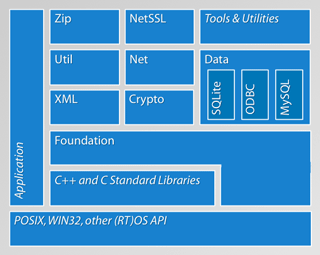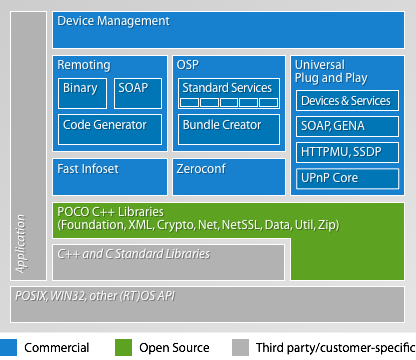POCO C++ Libraries提供一套 C++ 的類庫用以開發基于網絡的可移植的應用程序,功能涉及線程、文件、流,網絡協議包括:HTTP、FTP、SMTP 等,還提供 XML 的解析和 SQL 數據庫的訪問接口。不僅給我的工作帶來極大的便利,而且設計巧妙,代碼易讀,注釋豐富,也是非常好的學習材料,我個人非常喜歡。POCO的創始人在這個開源項目的基礎上做了一些收費產品,也成立了自己的公司,"I am in the lucky position to work for my own company",真是讓人羨慕啊。
POCO C++ Libraries

基于POCO的產品

Poco主頁:
http://pocoproject.org/Poco文檔:
http://pocoproject.org/docs/創始人主頁:
http://obiltschnig.com/公司主頁:
http://www.appinf.com/我主要用過Net,Data,XML部分,Net里對socket的封裝類,實現TCP,HTTP,SMTP協議的框架,Data里對MySQL接口封裝,XML里對DOM標準的實現。我目前主要是做C++網絡編程,曾經嘗試接觸ACE庫,但覺得太復雜難理解,而且也沒有條件用于項目,后來發現了Poco,不僅簡單易用,而且也包含《C++ Networking Programming》中提到的各種模式和框架,更難得的是文檔注釋豐富,看起源碼來相當舒服。因此想寫一些筆記,一方面借此加深對網絡編程的理解,另一方面也希望和大家多多交流。
第一篇討論Poco::TCPServer框架,先看看Poco::TCPServer有哪些類
 class Net_API TCPServer: public Poco::Runnable
class Net_API TCPServer: public Poco::Runnable
 class Net_API TCPServerConnection: public Poco::Runnable
class Net_API TCPServerConnection: public Poco::Runnable
 class Net_API TCPServerConnectionFactory
class Net_API TCPServerConnectionFactory
 class Net_API TCPServerDispatcher: public Poco::Runnable
class Net_API TCPServerDispatcher: public Poco::Runnable
 class Net_API TCPServerParams: public Poco::RefCountedObject
class Net_API TCPServerParams: public Poco::RefCountedObjectRunnable是一個抽象類,要求其子類實現一個run()函數,run()一般作為線程的入口函數.
先看看run函數是如何被調用的,以TCPServer為例。
 void TCPServer::start()
void TCPServer::start()


 {
{
 poco_assert (_stopped);
poco_assert (_stopped);

 _stopped = false;
_stopped = false;
 _thread.start(*this);//這里傳入本類對象地址
_thread.start(*this);//這里傳入本類對象地址
 }
}再看看Thread類的start函數
 class Foundation_API Thread: private ThreadImpl
class Foundation_API Thread: private ThreadImpl
 void Thread::start(Runnable& target)
void Thread::start(Runnable& target)


 {
{
 startImpl(target);
startImpl(target);
 }
}這里的ThreadImpl::startImpl是POSIX實現版本
 void ThreadImpl::startImpl(Runnable& target)
void ThreadImpl::startImpl(Runnable& target)


 {
{

 _pData->pRunnableTarget = ⌖
_pData->pRunnableTarget = ⌖
 if (pthread_create(&_pData->thread, &attributes, runnableEntry, this))
if (pthread_create(&_pData->thread, &attributes, runnableEntry, this))


 {
{
 _pData->pRunnableTarget = 0;
_pData->pRunnableTarget = 0;
 throw SystemException("cannot start thread");
throw SystemException("cannot start thread");
 }
}

pRunnableTarget就指向Runnable了
 void* ThreadImpl::runnableEntry(void* pThread)
void* ThreadImpl::runnableEntry(void* pThread)


 {
{

 ThreadImpl* pThreadImpl = reinterpret_cast<ThreadImpl*>(pThread);
ThreadImpl* pThreadImpl = reinterpret_cast<ThreadImpl*>(pThread);
 AutoPtr<ThreadData> pData = pThreadImpl->_pData;
AutoPtr<ThreadData> pData = pThreadImpl->_pData;
 try
try


 {
{
 pData->pRunnableTarget->run();//在這里
pData->pRunnableTarget->run();//在這里
 }
}
 catch (Exception& exc)
catch (Exception& exc)

知道run()是如何被調用了,再看看TcpServer::run()的實現
1 void TCPServer::run()
void TCPServer::run()
2

 {
{
3 while (!_stopped)
while (!_stopped)
4

 {
{
5 Poco::Timespan timeout(250000);
Poco::Timespan timeout(250000);
6 if (_socket.poll(timeout, Socket::SELECT_READ))
if (_socket.poll(timeout, Socket::SELECT_READ))
7

 {
{
8 try
try
9

 {
{
10 StreamSocket ss = _socket.acceptConnection();
StreamSocket ss = _socket.acceptConnection();
11 // enabe nodelay per default: OSX really needs that
// enabe nodelay per default: OSX really needs that
12 ss.setNoDelay(true);
ss.setNoDelay(true);
13 _pDispatcher->enqueue(ss);
_pDispatcher->enqueue(ss);
14 }
}
15 catch (Poco::Exception& exc)
catch (Poco::Exception& exc)
16


在第6行調用標準select函數,準備好讀后,第10行調用標準accept建立連接,然后把StreamSocke對象放入TCPServerDispatcher對象內的隊列中,可見TCPServer只是建立連接,之后的工作就都交給TCPServerDispatcher了。
在講TCPServerDispatcher之前,先需要說明的是第10行TCPServer的_socket成員變量類型是ServerSocket,ServerSocket在一個構造函數中調用了bind和listen,具體如下
 ServerSocket::ServerSocket(Poco::UInt16 port, int backlog): Socket(new ServerSocketImpl)
ServerSocket::ServerSocket(Poco::UInt16 port, int backlog): Socket(new ServerSocketImpl)


 {
{
 IPAddress wildcardAddr;
IPAddress wildcardAddr;
 SocketAddress address(wildcardAddr, port);
SocketAddress address(wildcardAddr, port);
 impl()->bind(address, true);
impl()->bind(address, true);
 impl()->listen(backlog);
impl()->listen(backlog);
 }
}
要注意,盡管ServerSocket類提供了無參構造函數,但使用無參構造函數創建的對象,在TCPServer對象調用start()之前,必須先bind和listen。
" /// Before start() is called, the ServerSocket passed to
/// TCPServer must have been bound and put into listening state."
繼續看TCPServerDispatcher,沿著TcpServer::run()第13行,我們看它的equeue()
1 void TCPServerDispatcher::enqueue(const StreamSocket& socket)
void TCPServerDispatcher::enqueue(const StreamSocket& socket)
2

 {
{
3 FastMutex::ScopedLock lock(_mutex);
FastMutex::ScopedLock lock(_mutex);
4
5 if (_queue.size() < _pParams->getMaxQueued())
if (_queue.size() < _pParams->getMaxQueued())
6

 {
{
7 _queue.enqueueNotification(new TCPConnectionNotification(socket));
_queue.enqueueNotification(new TCPConnectionNotification(socket));
8 if (!_queue.hasIdleThreads() && _currentThreads < _pParams->getMaxThreads())
if (!_queue.hasIdleThreads() && _currentThreads < _pParams->getMaxThreads())
9

 {
{
10 try
try
11

 {
{
12 static const std::string threadName("TCPServerConnection");
static const std::string threadName("TCPServerConnection");
13 _threadPool.start(*this, threadName);
_threadPool.start(*this, threadName);
14 ++_currentThreads;
++_currentThreads;
15 }
}
16 catch (Poco::Exception&)
catch (Poco::Exception&)
17


第7行enqueueNotification把一個TCPConnectionNotification入隊,第13行把this交給ThreadPool啟動一個線程,那么這個線程就要運行TCPServerDispatcher的run函數了,看TCPServerDispatcher::run()
1 void TCPServerDispatcher::run()
void TCPServerDispatcher::run()
2

 {
{
3 AutoPtr<TCPServerDispatcher> guard(this, true); // ensure object stays alive
AutoPtr<TCPServerDispatcher> guard(this, true); // ensure object stays alive
4
5 int idleTime = (int) _pParams->getThreadIdleTime().totalMilliseconds();
int idleTime = (int) _pParams->getThreadIdleTime().totalMilliseconds();
6
7 for (;;)
for (;;)
8

 {
{
9 AutoPtr<Notification> pNf = _queue.waitDequeueNotification(idleTime);
AutoPtr<Notification> pNf = _queue.waitDequeueNotification(idleTime);
10 if (pNf)
if (pNf)
11

 {
{
12 TCPConnectionNotification* pCNf = dynamic_cast<TCPConnectionNotification*>(pNf.get());
TCPConnectionNotification* pCNf = dynamic_cast<TCPConnectionNotification*>(pNf.get());
13 if (pCNf)
if (pCNf)
14

 {
{
15 std::auto_ptr<TCPServerConnection> pConnection(_pConnectionFactory->createConnection(pCNf->socket()));
std::auto_ptr<TCPServerConnection> pConnection(_pConnectionFactory->createConnection(pCNf->socket()));
16 poco_check_ptr(pConnection.get());
poco_check_ptr(pConnection.get());
17 beginConnection();
beginConnection();
18 pConnection->start();
pConnection->start();
19 endConnection();
endConnection();
20 }
}
21 }
}

第9行waitDequeueNotification一個Notification,第12行把這個通知類型轉換成TCPConnectionNotification,聯系之前的enqueueNotification,大概能才到是什么意思。第15行又出現個TCPServerConnection。好吧,看來搞清楚TCPServerDispatcher還是要先看下TCPServerConnection,還有TCPConnectionNotification。
盡管TCPServerConnection繼承了Runable,但沒有實現run(),它的start()如下
 void TCPServerConnection::start()
void TCPServerConnection::start()


 {
{
 try
try


 {
{
 run();
run();
 }
}


用戶需要繼承TCPServerConnection實現run函數,看下源碼中的說明,要完成對這個socket的處理,因為run函數返回時,連接就自動關閉了。
 class Net_API TCPServerConnection: public Poco::Runnable
class Net_API TCPServerConnection: public Poco::Runnable

 /**//// The abstract base class for TCP server connections
/**//// The abstract base class for TCP server connections
 /// created by TCPServer.
/// created by TCPServer.
 ///
///
 /// Derived classes must override the run() method
/// Derived classes must override the run() method
 /// (inherited from Runnable). Furthermore, a
/// (inherited from Runnable). Furthermore, a
 /// TCPServerConnectionFactory must be provided for the subclass.
/// TCPServerConnectionFactory must be provided for the subclass.
 ///
///
 /// The run() method must perform the complete handling
/// The run() method must perform the complete handling
 /// of the client connection. As soon as the run() method
/// of the client connection. As soon as the run() method
 /// returns, the server connection object is destroyed and
/// returns, the server connection object is destroyed and
 /// the connection is automatically closed.
/// the connection is automatically closed.
 ///
///
 /// A new TCPServerConnection object will be created for
/// A new TCPServerConnection object will be created for
 /// each new client connection that is accepted by
/// each new client connection that is accepted by
 /// TCPServer.
/// TCPServer.連接在哪被關閉的呢,注釋說隨著TCPServerConnection對象銷毀而關閉。具體就是,TCPServerConnection類有個StreamSocket成員,StreamSocket繼承自Socket,Socket類又包含了個SocketImpl成員,所以就有~TCPServerConnection()->~StreamSocket()->~Socket()->~SocketImpl(),最后~SocketImpl()調用close()關閉了連接。
那么TCPServerConnection對象何時被創建何時被銷毀呢,這下又回到TCPServerDispatcher::run()來了,看TCPServerDispatcher::run()的第15行,創建了TCPServerConnection對象,第18行調用TCPServerConnection::start()進而調用TCPServerConnection::run(),第20行塊結束,TCPServerConnection對象隨著智能指針銷毀而被銷毀。
還剩TCPConnectionNotification或者說Notification要搞清楚了,但是要對Poco的Notifactions模塊源碼進行分析的話,本文的篇幅也就太長了,就從文檔來大致看看吧
Notifications
Facilities for type-safe sending and delivery of notification objects within a single thread or from one thread to another, also well suited for the implementation of notification mechanisms. A notification queue class for distributing tasks to worker threads, simplifying the implementation of multithreaded servers.
簡單的說Notifications模塊可用于線程間傳遞消息,簡化多線程服務器的實現。具體到TCPServer,就是把已連接的socket,放到NotificationQueue中,并從TheadPool出來一個線程,線程從NotificationQueue取到這個socket,從而用TCPServerConnection::run()里的邏輯對socket進行處理。
至此TCPServer基本分析完畢,還有TCPServerConnectionFactory和TCPServerParams,分別用于產生TCPServerConnection和設置參數,就不細說了。
縱觀Poco::TCPServer,套一下
《Unix Network Programming》里講的服務器模型,屬于“在程序啟動階段創建一個線程池之后讓主線程調用accept,并把每個客戶連接傳遞給池中某個可用線程”。Poco1.3.6版里用select作為IO multiplexing。1.3.7版正在嘗試epoll(windows平臺依然是select),但還未release,跟蹤svn來看也沒有使用edge-triggered模式。套用《The C10K problem》里講的服務器模型,屬于"Serve many clients with each thread, and use nonblocking I/O and level-triggered readiness notification"。總結起來就是:non-blocking IO + IO multiplexing(level-triggered) + thread pool。
Poco::TCPServer也許并不能算一個性能很高的TCP服務器,但我非常喜歡它的設計和編碼風格。順便提一下對底層socket的封裝,由socket類派生的各種子類,ServerSocket在構造函數中進行bind和listen,StreamSocket在構造函數進行connect,都是非常貼心的設計。
下一篇打算分析Poco的Reator框架。